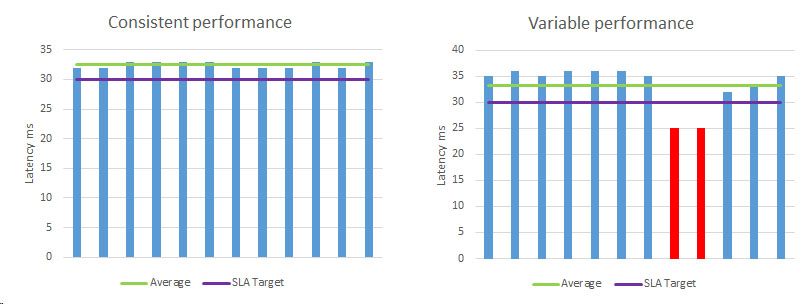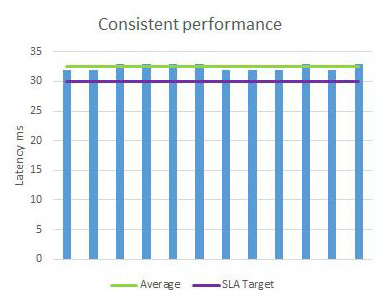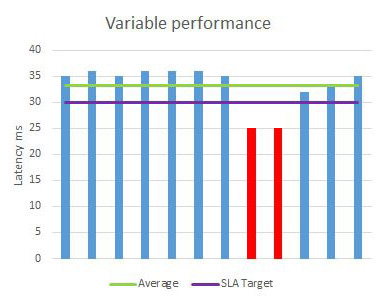Service Level Agreements
SLAs Matter
In the complex market of internet connectivity, how do you differentiate between services when you only know the headline bandwidth?
Service Level Agreements (SLAs) define the parameters that differentiate connections that deliver consistent performance
from those that don’t.
What is an SLA?
SLAs form part of your contract with your supplier. They ensure your supplier delivers to an agreed level of service.
When it comes to connectivity there are two key SLAs that matter. Service and Performance. It’s normal to focus on a Service SLA – how quickly will a fault be fixed if it occurs – but when it comes to business grade connectivity consistent performance is essential to support today’s demanding applications. This is why a connection backed by a Performance SLA is superior to one without.
Most services will come with a service SLA that determines at what point a degradation in service becomes a fault and how quickly the fault will be resolved. Loss of connectivity could result in significant business disruption which is why Spitfire always includes the highest service level available on all Ethernet services and recommend enhanced service levels on all broadband circuits. SLA backed repair times are therefore as little as 5 hours and 7 hours respectively and available 24×7. By comparison a residential or basic business service may leave you without service for up to 5 working days.
Why consistency matters
When it comes to performance consistency is the key. Average isn’t good enough. An inconsistent connection may well meet an average Performance SLA at times but that doesn’t mean it won’t cause you problems. There may be times when the circuit performance is poor and cause issues yet the SLA is still met. Your VoIP call may fail, your video call may break up, your file transfer may take significantly longer. Your SLA needs to offer consistent Performance, not average.

To find out more about Spitfire’s award winning connectivity and market leading SLAs contact us:
020 7501 333 or 0800 319 6000.
HOW TO MEASURE PERFORMANCE …
For connectivity there are 4 key metrics that need to be consistently met. If the performance of the connection drops even slightly for any of these metrics at any point sensitive applications like VoIP will suffer. Significant or longer issues will have a notable impact on every aspect of your business.
- Bandwidth – how much data your connection can pass in a given time
- Latency – how quickly your data gets from your office to the service provider network
- Packet Loss – how much data reaches the destination
- Jitter – the variation in latency
PERFORMANCE SLA TARGETS FOR VOIP …
To ensure business grade call quality for VoIP the following should be consistently achieved when measured from mouth to ear:
Latency <150ms
Packet Loss <1%
Jitter <45m
UNDERSTANDING AN SLA …
SLAs are based on a calculation that uses network monitoring statistics to determine performance. A Calculation then compares these statistics to your SLA thresholds to determine if there is a fault. How the SLA is calculated and over what time frame are therefore important details. For example;
A circuit with a 99.9% uptime SLA measured annually could be down for a whole working day yet be within SLA
The same SLA measured monthly gives a maximum outage of only 44 minutes before breaching SLA.
Which of these SLAs better suits your business?
WHAT HAPPENS WHEN THE SLA IS BREACHED? …
What does a guarantee actually offer? A good SLA will tell you what happens if the SLA isn’t met. This may for example be service credits until the issue is resolved which is a huge incentive to the supplier to keeping pushing for a resolution.
However look out for “guarantees” that don’t solve your problem. A provider who offers a discount on your rental if your bandwidth drops hasn’t resolved your issue – the service may be useless, you’ve just reduced your bill slightly.
What use is a guarantee that reduces your service fee but doesn’t rectify the shortcoming?
WHY SLAS MATTER …
There’s a good reason performance SLAs are offered on some circuits – because these circuits are designed for consistently high performance. The type of performance that ensures demanding applications like Voice over IP work consistently.
SLAs are a clear differentiator that allow you to make an informed choice. If there is no SLA available chances are that the technology either cannot support a consistent guaranteed level of performance or the service provider has designed the service to reduce cost.
WHEN SHOULD I EXPECT AN SLA …
All connections should be offered with a support SLA so make sure you understand which service level you sign up to.
Different circuit types are capable of supporting different performance SLAs. For example a Broadband circuit such as FTTC broadband by design has many variables that make it difficult for a service provider to offer any useful level of performance SLA. You may get a minimum target bandwidth or prioritised traffic but even these are rarely underpinned by any contractual obligation. Conversely ethernet circuits are designed to optimise network performance and remove the unpredictability caused by network congestion. Performance SLAs do still however vary. It is not uncommon for a performance SLA to only be offered on a proportion of the allocated bandwidth. This may well suit your needs but requires careful router configuration to ensure the mechanisms in place are correctly utilised.
Why consistency matters
When it comes to performance consistency is the key. Average isn’t good enough. An inconsistent connection may well meet an average Performance SLA at times but that doesn’t mean it won’t cause you problems. There may be times when the circuit performance is poor and cause issues yet the SLA is still met. Your VoIP call may fail, your video call may break up, your file transfer may take significantly longer. Your SLA needs to offer consistent Performance, not average.


To find out more about Spitfire’s award winning connectivity and market leading SLAs contact us:
020 7501 333 or 0800 319 6000.
HOW TO MEASURE PERFORMANCE …
For connectivity there are 4 key metrics that need to be consistently met. If the performance of the connection drops even slightly for any of these metrics at any point sensitive applications like VoIP will suffer. Significant or longer issues will have a notable impact on every aspect of your business.
- Bandwidth – how much data your connection can pass in a given time
- Latency – how quickly your data gets from your office to the service provider network
- Packet Loss – how much data reaches the destination
- Jitter – the variation in latency
PERFORMANCE SLA TARGETS FOR VOIP …
To ensure business grade call quality for VoIP the following should be consistently achieved when measured from mouth to ear:
Latency <150ms
Packet Loss <1%
Jitter <45m
UNDERSTANDING AN SLA …
SLAs are based on a calculation that uses network monitoring statistics to determine performance. A Calculation then compares these statistics to your SLA thresholds to determine if there is a fault. How the SLA is calculated and over what time frame are therefore important details. For example;
A circuit with a 99.9% uptime SLA measured annually could be down for a whole working day yet be within SLA
The same SLA measured monthly gives a maximum outage of only 44 minutes before breaching SLA.
Which of these SLAs better suits your business?
WHAT HAPPENS WHEN THE SLA IS BREACHED? …
What does a guarantee actually offer? A good SLA will tell you what happens if the SLA isn’t met. This may for example be service credits until the issue is resolved which is a huge incentive to the supplier to keeping pushing for a resolution.
However look out for “guarantees” that don’t solve your problem. A provider who offers a discount on your rental if your bandwidth drops hasn’t resolved your issue – the service may be useless, you’ve just reduced your bill slightly.
What use is a guarantee that reduces your service fee but doesn’t rectify the shortcoming?
WHY SLAS MATTER …
There’s a good reason performance SLAs are offered on some circuits – because these circuits are designed for consistently high performance. The type of performance that ensures demanding applications like Voice over IP work consistently.
SLAs are a clear differentiator that allow you to make an informed choice. If there is no SLA available chances are that the technology either cannot support a consistent guaranteed level of performance or the service provider has designed the service to reduce cost.
WHEN SHOULD I EXPECT AN SLA …
All connections should be offered with a support SLA so make sure you understand which service level you sign up to.
Different circuit types are capable of supporting different performance SLAs. For example a Broadband circuit such as FTTC broadband by design has many variables that make it difficult for a service provider to offer any useful level of performance SLA. You may get a minimum target bandwidth or prioritised traffic but even these are rarely underpinned by any contractual obligation. Conversely ethernet circuits are designed to optimise network performance and remove the unpredictability caused by network congestion. Performance SLAs do still however vary. It is not uncommon for a performance SLA to only be offered on a proportion of the allocated bandwidth. This may well suit your needs but requires careful router configuration to ensure the mechanisms in place are correctly utilised.






We’re here to help!
Enquire now about your chosen product
020 7501 3333 or 0800 319 6000
.
.
.
.
Thank you for contacting us.
SLA Enquiry

We’re here to help!
Enquire now about your chosen product
Please complete your details and we will contact you shortly. Alternatively feel free to call or email our team on:
020 7501 3333 or 0800 319 6000
SLA Enquiry

Thank you for contacting us
Please complete your details and we will contact you shortly to confirm availability and pricing.
SLAs
To view our privacy policy click here
